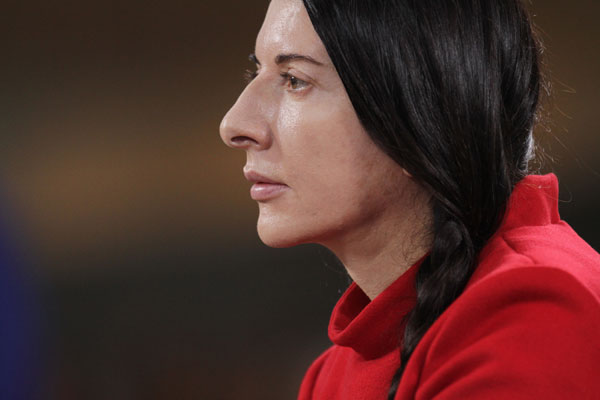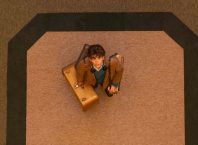Perfomance art is at once a challenge and an opportunity. If one cleaves to traditional definitions of art – you know, stuff about composition, balance, aesthetic appeal and so on – then its difficult to think of performance art as, you know, art. But this definition is narrow, self limiting: I’d rather think of art as a conduit to our emotional hinterland, giving access to the sensations and feelings and thoughts and ideas that are circumscribed by the rigidity of our everyday lives. Art – good art, anyway – offers the opportunity to reflect on these; it creates a space to make contact with our hidden selves. That’s what I think, anyway.
Early on in Marina Abramovic – The Artist Is Present, someone observes that on average, a person looks at a work of art for 30 seconds. Just 30 seconds. Enough time, I suppose, to decide whether a piece catches one’s fancy; nowhere near enough to think about whether a piece can create meaning in one’s life. And therein lies both the challenge and the opportunity for performance art. Once you’ve reeled the unsuspecting punter in, you will keep their attention for more than 30 seconds. The problem is how to reel them in.
++++++++++++++++++++++++++++++++++++++++++++++++++++++++++++++++++++
Performance art, as descriptions go, is something of a misnomer. The word “performance” infers acting, a stage; performance art, however, is anything but. How did someone put it? “The difference between performing and acting is that with performing, it’s a knife, your blood; with acting, it’s a stage prop and ketchup.”
Marina Abramovic is a performer; the dominant key of her performances works is disruption, both to herself and to her audience. There can be a humorous edge to this, like Imponderabilia (1977) where entrants to a gallery were obliged to squeeze themselves through a narrow aperture, flanked by Abramovic and her partner of the time, Ulay. Both naked. Elsewhere, it is willfully disturbing. Take Rhythm O (1974) for instance, a six hour performance in Naples. To the audience, she presented herself, 72 objects and a simple instruction: To be used on her as desired. Passive throughout, Abramovic was stripped, daubed with slogans, placed on a table, photographed. It’s a disturbing commentary on the mechanics of group psychology and the limits to which an audience can be taken once the conventional restraints are removed. It’s also remarkable that two of the 72 items were a gun and a bullet; remarkable that they were there, and that they were not used.
++++++++++++++++++++++++++++++++++++++++++++++++++++++++++++++++++++
“I want to be a real form of art before I die,” Marina Abramovic says. It’s a strange comment, candid and truthful yet somewhat disingenuous at the same time. It isn’t very often that an artist is offered a retrospective that covers the whole of MOMA – that temple to modern art – after all. But she is right. Performance art, art that relies on the communication between audience and performer, is still treated with a degree of suspicion. All that said, The Artist Is Present – follows Abramovic as she prepares for her MOMA residency, which ran between March and May 2010. It is a rare privilege for an artist to be accorded such an honor; its very occurrence captures the essence of the contradictions that she inhabits. She is a narcissist, but remarkably selfless about it; she affects indifference about whether her audiences make an icon out of her, but at the same time cannot be if she cannot connect with her audiences.
Narcissism is not necessarily a bad thing. It is, after all, nothing more than an excessive – or erotic – interest in one’s physical appearance. It’s fair comment, I’d argue, to make of someone who puts herself and her physicality at the centre of much of her work. But it matters is because Abramovic channels an extraordinary relationship with her corporeal and emotional self into her art. And through this, evokes – provokes, perhaps -her audiences.
++++++++++++++++++++++++++++++++++++++++++++++++++++++++++++++++++++
The Artist Is Present, whilst not dramatically revelatory, is a well-organized and considered assessment of Abramovic the phenomena; more than enough to satisfy a casual curiosity, but falling a little short in explaining Abramovic the artist. This is no fault of the film’s principal: she is as open and as revealing as one might expect, granting the filmmakers a remarkable access as she prepares for her retrospective. She takes a body of assistants away for a weekend, to take part in a rather unique form of quasi-corporate bonding (Cell phones given up on commencement, three days’ fasting, skinny dipping, you know that kind of thing); she considers the detail and minutiae of the exhibition. She considers a collaboration with the illusionist David Blaine (the opinion of her gallerist: “I oppose it with every fiber of my being.”); gradually things coalesce into a meaningful whole. The show could be divided into three areas. A retrospective of her considerable corpus of work; the performance – as opposed to the restaging – of some of her signature pieces. And at the core, the centerpiece of the retrospective and of the film: the eponymous performance piece. Seven hours a day, six days a week, Abramovic sitting, solitary, still, in a designated space and steadily meeting the gaze of anyone and everyone who sits across from her at table, six feet away.
“Every profession has its tool: for me, performance is the tool I choose to bringing me to the moment,” Abramovic once wrote. And The Artist Is Present – both the performance and the exhibition – was about the moment. About slowing time down to an infinitesimal crawl, about forcing the participants in the performance to be actually present, to inhabit the stillness that is created between themselves and the artist. There is an artificiality to it, of course; but what seemed more interesting was the centrality of the performer to the performance. Without her presence, mental and physical, it would all be to nought.
++++++++++++++++++++++++++++++++++++++++++++++++++++++++++++++++++++
In retrospect, perhaps the filmmakers might agree that concentrating the last third of the film on Abramovic’s performance of The Artist Is Present might have been unwise. It’s not that the scrutiny strips the piece of its mystique (although the sub-plot involving the attendance of Ulay, her ex-lover and collaborator, on the opening night turns out to be perhaps a little less extravagant, a little more pedestrian, than had been suggested at the time. But art is about showmanship, no?) It’s more to do with what it reveals – but doesn’t resolve – about the ambiguity of the relationship between Abramovic and her audience. At some point, The Artist Is Present becomes a spectacle, part of the cyclical calendar of events, a participation event simply because one must do these things rather than because it holds out the possibility – no matter how slight – of charting a path to one’s unconscious. By the time a reporter from Fox rolls her eyes and asks rhetorically “is this what they call art?” the old dichotomies have been put in place. This is not Abramovic’s fault, of course. Her commitment cannot be questioned. But can she really be unconcerned by this contradiction?
++++++++++++++++++++++++++++++++++++++++++++++++++++++++++++++++++++
Of course, one recognizes the irony in writing this – it comes perilously close to saying “I got it, but I’m not sure anyone else did.” Which, if nothing else, is an elitism that actually doesn’t exist in her work.
++++++++++++++++++++++++++++++++++++++++++++++++++++++++++++++++++++
The Artist Is Present covers the Abramovic performance more effectively as a media phenomena, not because the film – like the art – might offer a path to deeper understanding. This sounds harsh, and is not intended to be entirely thus. But it is true, I think. The requisite talking heads are most interesting when relating to Abramovic the media sensation, and less revealing when talking about Abramovic the artist. And there is a lot to say about her. But we only approach this sporadically – like, for instance, when she talks about being dressed up as a devil by her mother when she was four, or when she talks about her strained relationship with her parents, Yugoslav war heroes and patriots and disciplinarians. The rest of the time, we just get to admire her from a distance. Look, but don’t attempt to touch.
++++++++++++++++++++++++++++++++++++++++++++++++++++++++++++++++++++
“Performance is all about state of mind. Public is like a dog, it can sense insecurity, fear (sic),” Abramovic explains. “The question is how to bring performance and public to the same consciousness, the same here and now.” It’s as close to a manifesto statement as she comes throughout the film. I’m not entirely sure we, the viewer, finish the film any closer to understanding how she does this. But seeing the satisfaction, the palpable relief mixed with exhaustion, mental collapse, that she experiences at the end, we get to understand why. And that, in itself, is something.
Marina Abramovic – The Artist is Present was screened at the Docaviv 2012 Festival, and will have one more screening on May 12th at 19:45






